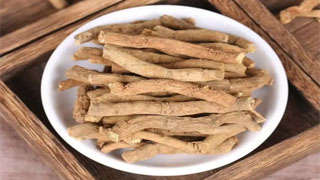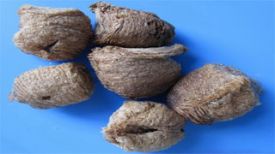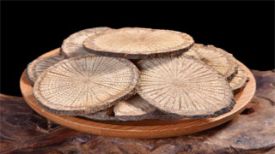
1. Alias
Aristolochia root, bell root, and wisteria fragrance.
2. Plant morphology
Grass vine. Root cylindrical shape. The stem is delicate and hairless. Leaves alternate, petioles are delicate, leaf blades are ovate triangular, oblong ovate, or halberd shaped, tips are blunt rounded or shortly pointed, base is heart-shaped, lobes on both sides are round, drooping or slightly expanding; There are 5-7 basal veins, and the veins at all levels are clearly visible on both sides. The flowers are solitary or clustered in the leaf axils, with triangular bracteoles that are easy to fall off. The base of the perianth expands into a spherical shape and narrows upwards into a long tube. The opening of the tube expands into a funnel-shaped shape, yellow green in color, with purple spots on the mouth and glandular hairs on the inner surface. One side of the eave is extremely short, and the other side gradually extends into a tongue. The tongue is ovate lanceolate, with a blunt tip. The anthers are attached to the near base of the stamen column, and the ovary is cylindrical with 6 edges. The apex of the stamen column is 6-lobed, slightly nipple shaped, and the tips of the lobes are blunt, extending downward to form a wavy ring. The capsule is nearly spherical, with a rounded and slightly concave tip and 6 edges. When mature, it splits into 5 petals along the interventricular space from the base upwards, and the stem is often torn into 6 strips. The seed is flat, blunt triangular, with white membranous wings at the edges. The flowering period is from July to August, and the fruiting period is from September to October.
3. Origin distribution
Born in damp valleys, ravines, or slopes filled with soil. Distributed in various regions south of Shandong, Henan, and the Yangtze River Basin.
4. Harvesting and processing
When the stems and leaves wither from October to November, dig out the roots, remove the roots and soil, and dry them in the sun.
5. Characteristics of medicinal herbs
This product is cylindrical or slightly flat, slightly curved, measuring 3-10 centimeters in length and 0.5-1.5 centimeters in diameter. The surface is yellow brown or gray brown, with longitudinal wrinkles and root scars. The texture is firm and brittle, with a faintly visible layer ring formed by the fracture surface. The skin is light yellow, the wood rays are broad and milky white, and the wood bundles are light yellow and radiating. The conduit holes are obvious. The aroma is unique and the taste is bitter.
6. Sexual Taste Returning to the Classics
Cold in nature, pungent and bitter in taste. Return to the lung meridian, stomach meridian, and liver meridian.
7. Effect and Function
Promote qi circulation to relieve pain, detoxify and reduce swelling, calm the liver and lower blood pressure. It belongs to the category of Qi regulating medicine.
8. Clinical application
Oral administration: decoction, 3-9g; At the end of the study, take 1.5-2 grams 2-3 times a day. External use: appropriate amount, apply after grinding; Or grind the juice and apply it. Indications include chest, rib, and abdominal pain, hernia pain, enteritis, diarrhea, abdominal pain, cough, phlegm, wheezing, snake and insect bites, abscesses, eczema, skin itching, and hypertension.
9. Pharmacological research
Inhibit smooth muscle movement; Analgesia and anti-inflammatory; Resistance to pathogens; step-down; calm; Induce vomiting; Relaxing striated muscles, etc.
10. Chemical composition
Qingmu Xiang mainly contains volatile oil, which is mainly composed of Aristolochiacol, and also contains Aristolochic acid, Allantoin, Qingmu Xiang acid, Magnolia alkaloids, Turquoise A and C, etc.
11. Usage taboos
People with spleen and stomach deficiency and cold should take it with caution. Overdosing can cause gastrointestinal reactions such as nausea, vomiting, bloating, abdominal pain, bitter mouth, dry mouth, etc.
12. Compatibility prescription
① Treatment for enteritis, abdominal pain, and dysentery: 9g of Qingmuxiang, 4.5g of betel nut, and 4.5g of Huanglian. Grind the powder together and rinse with warm water. (Modern Practical Traditional Chinese Medicine)
② Treat heatstroke and abdominal pain: Take 9-15g fresh Qingmu Xianggen, mash juice, and warm water; Also use 3-6 grams of Eucommia ulmoides root, grind into powder, and take with warm water. (Jiangxi Herbal Medicine)
③ Treating toothache: Take a piece of fresh green wood fragrance and bite into the toothache area. (Handbook of Commonly Used Chinese Herbal Medicines in Northeast China)
④ Treating persistent bleeding during urination in women: 30g each of Eucommia ulmoides root and Cirsium sibiricum root. Mash the fine Luo into powder. Before each consumption, add 6 grams of Danggui wine. (Holy Blessing Formula)
⑤ Treating armpit qi: Make thick slices of green wood fragrance, soak them in vinegar overnight, clip them under the armpits several times, and they will heal. (Hygiene Easy Recipe)
⊙ The content of the article is for clinical reference only. Non TCM professionals are not allowed to test drugs.


